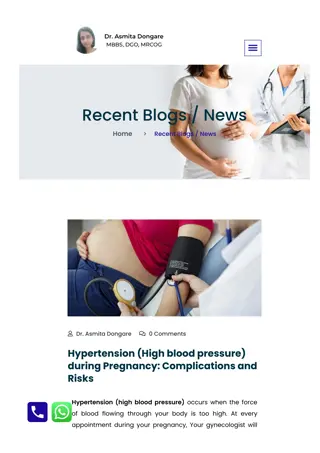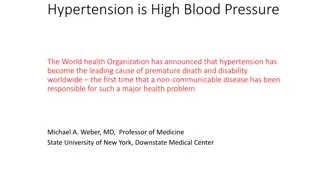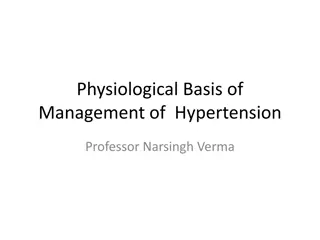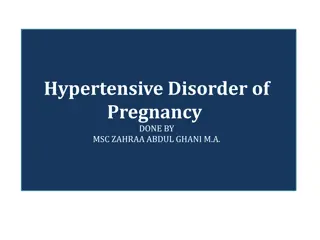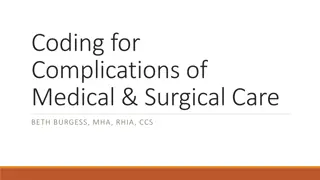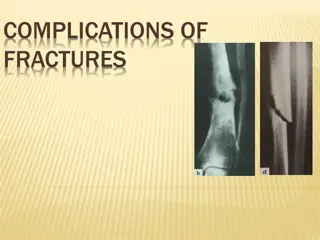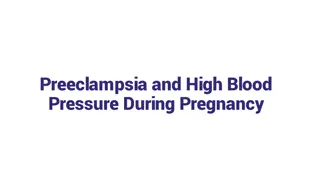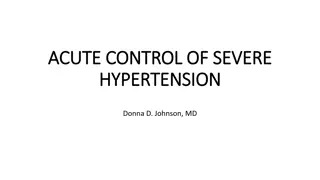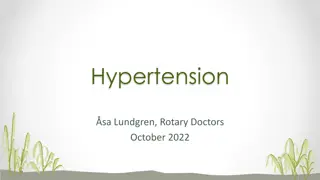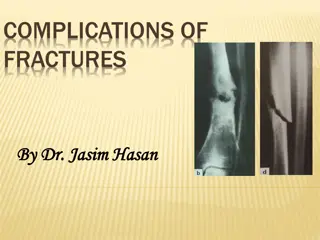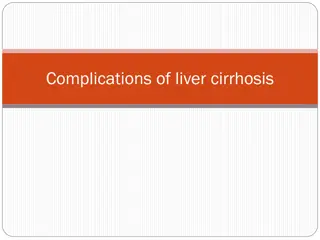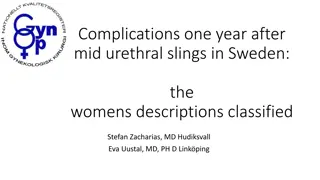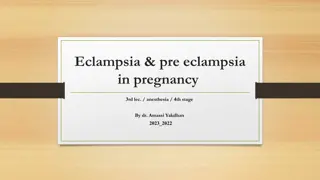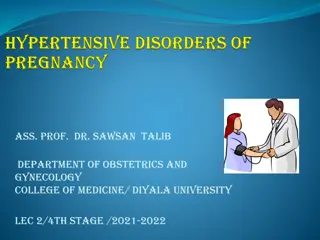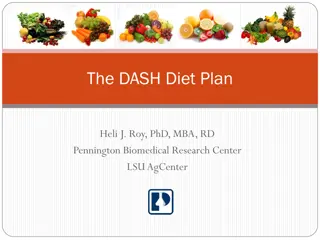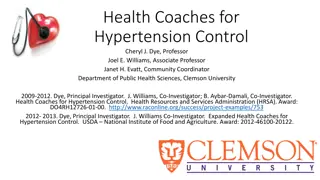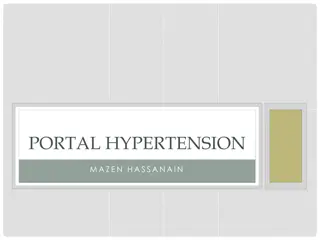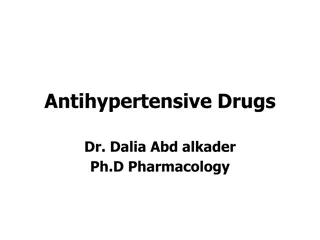Understanding Hypertension: Causes, Classification, and Complications
Hypertension, a common yet serious health issue, is explored in detail in this lecture. The etiology, risk factors, and complications of hypertension are discussed, along with the classification into primary, secondary, benign, and malignant hypertension. The lecture also covers causes of secondary hypertension, such as renal diseases, endocrine disorders, and vascular abnormalities. Understanding hypertension is crucial as it is a major contributor to conditions like atherosclerosis, renal failure, and cardiovascular disease.
Download Presentation

Please find below an Image/Link to download the presentation.
The content on the website is provided AS IS for your information and personal use only. It may not be sold, licensed, or shared on other websites without obtaining consent from the author. Download presentation by click this link. If you encounter any issues during the download, it is possible that the publisher has removed the file from their server.
E N D
Presentation Transcript
Pathology teamwork Lecture (4): HYPERTENSION HYPERTENSION Editing File Color Index :- VERY IMPORTANT Extra explanation Examples Diseases names: Underlined Definitions *The expert in anything was once a beginner
Objectives: At the end of the lecture, the student should: Know the a etiology, risk factors and complications of hypertension, so as to be able to identify patient risk factors amenable to treatment by lifestyle modification, and to investigate patients appropriately for causes of secondary hypertension. \ Objectives : Key principles to be discussed: Raised systemic blood pressure is a major cause of morbidity and mortality. Hypertension can cause or contribute to: atherosclerosis, left ventricular hypertrophy, chronic renal failure, cerebrovascular disease and retinopathy. Normal values for blood pressure. Causes of secondary hypertension. Genetic and environmental factors contributing to The etiology of essential hypertension Pathology of blood vessels (blood vessels changes) in both primary and secondary hypertension. LECTURE OUTLINE Definition and risk factors Classification Primary & secondary HTN Causes of secondary HTN Benign vs malignant HTN Pathogenesis Regulation of blood pressure Vascular morphology in HTN Heart in HTN Complications of HTN
Hypertension and Hypertensive Vascular Disease Hypertension: Definition: a sustained more than 1 reading systolic pressure in excess of 140 mm Hg or a sustained diastolic pressure more than 90 mm Hg (>140/90). Common problem Asymptomatic until late - Silent Killer painless. In the early stages of HTN there are few or no symptoms. Complications alert to diagnosis but late. Hypertension is an important factor which contributes in development of: Coronary Heart Cerebrovascular Cardiac Congestive Heart Disease Accident (stroke) Hypertrophy Failure Aortic Dissection Renal Failure Retinopathy Risk Factors for Hypertension Hereditary, Genetics- family history Lifestyle-stressful Race: African-Americans Heavy alcohol consumption Gender: Men & postmenopausal women Diabetes Age Use of oral contraceptives Obesity Sedentary or inactive lifestyle Diet, particularly sodium intake Hypertension Classification Hypertension Etiology or Cause Clinical Features Primary/Essenti al/idiopathic (95%) Secondary (5-10%) Malignant (5%) Benign Classification: based on etiology/cause: Primary/Essential Hypertension (95%) : Mechanisms largely unknown. It is idiopathic. Secondary Hypertension (5-10%): it can be due to pathology in the renal, endocrine, vascular or neurogenic systems. There is a definitive cause.
Causes of Secondary Hypertension Glomerulonephritis, Renal artery stenosis, Renal vasculitis Adult polycystic disease Chronic renal disease, Renin producing tumors Renal Adrenocortical hyperfunction (Cushing syndrome, primary aldosteronism, congenital adrenal hyperplasia) Hyperthyroidism/Thyrotoxicosis Hypothyroidism/Myxedema, Pheochromocytoma Acromegaly Exogenous hormones (glucocorticoids, estrogen e.g. oral contraceptives) Pregnancy-induced Endocrine Coarctation of aorta Vasculitis e.g.Polyarteritis nodosa Increased intravascular volume Increased cardiac output Rigidity of the aorta Vascular Psychogenic Increased intracranial pressure Sleep apnea Acute stress, including surgery Neurogenic Classification: based on clinical features: Benign: (mild form) The BP is at modest level (not very high). It can be idiopathic HTN or secondary HTN. Fairly stable over years to decades. Compatible with long life. Malignant (5%): There is rapidly rising BP which often leads to end organ damage. It can be a complication of any type of HTN (i.e. essential idiopathic/primary or secondary). It is seen in 5% of HTNsive patients. The diastolic pressure is usually over 120mmHg. admission to hospital. It is associated with: mainly kidney, retina, heart and brain Widespread arterial necrosis and thrombosis Rapid development of renal failure Retinal hemorrhage and exudate, with/without papilledema Hypertensive encephalopathy brain stop working Left ventricular failure Leads to death in 1 or 2 years if untreated Dr said, mainly know the place of complications.
Regulation of Blood Pressure (BP) BP Cardiac output Peripheral Resistance There are 2 hemodynamic variables that are involved in the regulation of BP. cardiac output => is affected by blood volume and is dependent on sodium concentrations when the Na conc. increase => water also will increase => blood volume increase => CO increase => BP increase peripheral vascular resistance => it is the resistance of the arteries to blood flow. - when arteries constrict resistance - when they dilate resistance . - Peripheral resistance is regulated at the level of the arterioles (also known as resistance vessels) and is determined by three factors: 1. Autonomic activity: sympathetic activity constricts peripheral arteries. 2. Pharmacologic agents: vasoconstrictor drugs increase resistance while vasodilator drugs decrease it. 3. Blood viscosity: increased viscosity increases resistance. Normal BP is maintained by a balance between factors that induce vasoconstriction (e.g. angiotensin II and catecholamines) and factors that induce vasodilation (e.g. kinins, prostaglandins, and nitric oxide). Note: An increased blood flow in the arterioles induces vasoconstriction to protect tissues against hyperperfusion if the blood flow to an organ such as kidney increases, this may cause tissue damage due to hyperperfusion. So the arterioles will contract to decrease that blood flow and therefore protect the organ. -When exercising systolic (blood volume) increases, but diastolic (peripheral resistance) is not much changed.
PATHOGENESIS of Essential Hypertension Why does essential HTN occurs? when the relationship between cardiac output and peripheral resistance is altered. How does that happen? Multiple genetic and environmental factors ultimately increase the cardiac output and/or peripheral resistance 1. Genetic factors: There is a strong genetic component (family history) e.g. a genetic effect is involved in making people more susceptible or less susceptible to high salt diet etc. a. Defect in renal sodium homeostasis: Reduce renal sodium excretion( )is a key initiating event in most forms of essential hypertension. This is usually due to defect in cell membrane function: affecting Na/Ca transport increase in fluid volume decreased sodium excretion increase in cardiac output elevated BP b. Functional vasoconstriction: abnormality in vascular tone such as increased sympathetic stimulation will cause vasoconstriction leading to increased peripheral resistance. c. Structural abnormality in vascular smooth muscle also leads to increased peripheral resistance. d. Also rare gene disorders can cause HTN by increasing renal sodium reabsorption e.g. Liddle syndrome. Liddle syndrome is an inherited autosomal dominant type of HTN, that begins in childhood. It is caused by mutations of the epithelial sodium channel protein (ENaC) which leads to increased sodium reabsorption in the renal tubules (followed by water), which leads to hypertension. Reabsorption of sodium is also correlates with potassium loss (hypokalemia). NOTE that in liddle syndrome there will be in increase Na reabsorption but the if defect in cell membrane function: affecting Na/Ca transport will there will be decrease in Na excretion. 1. Environmental factors: stress obesity smoking physical inactivity heavy consumption of salt NOTE: In hypertension, both increased blood volume and increased peripheral resistance contribute to the increased pressure. However reduced renal sodium excretion in the presence of normal arterial pressure (initially) is probably a key initiating event. ( )-If Na+ is in blood water retention increasing the blood volume causing hypertension.
ENDOCRINE FACTORS: role of renin- angiotensin- aldosterone in regulating BP Atrial natriuretic peptide / factor / hormone (Cardionatrine / Cardiodilatine / atriopeptin) -It is a protein (polypeptide) hormone secreted by the heart muscle cells in the atria of heart (atrial myocytes). -It is a powerful vasodilator and is involved in the homeostatic balance of body water, sodium, potassium and fat. -It is released in response to high blood volume. It acts to reduce the water, sodium and adipose loads on the circulatory system, thereby reducing blood pressure. -It has exactly the opposite function of the aldosterone secreted by the zona glomerulosa In the kidney: decreases sodium reabsorption and increases water loss. Inhibits renin secretion, thereby inhibiting the renin angiotensin aldosterone system In adrenal gland: Reduces aldosterone secretion by the zona glomerulosa of the adrenal cortex. In arterioles: Promotes vasodilation In adipose tissue: Increases the release of free fatty acids from adipose tissue.
Morphology of blood vessels in HTN: -In large Blood Vessels (Macroangiopathy) Atherosclerosis. HTN is a major risk factor in AS. -In small Blood Vessels (Microangiopathy) Arteriolosclerosis *remember first slide of atherosclerosis lecture*. Small blood vessels (Arteriolosclerosis): Hyaline arteriolosclerosis: -Seen in benign hypertension. -Can also be seen in elderly and diabetic patients even without hypertension. -Can cause diffuse renal ischemia which ultimately leads to benign nephrosclerosis. -No nuclei, collagen everywhere. Hyperplastic arteriolosclerosis: -Characteristic of malignant hypertension. -Can show onion-skinning on histology causing luminal obliteration of vascular lumen -May be associated with necrotizing arteriolitis and fibrinoid necrosis of the blood vessel. *Fibrinoid necrosis occurs due to: 1- Autoimmune disease. 2- Malignant hypertension. A. Hyaline arteriolosclerosis: hyalinosis of arteriolar wall with narrowing of lumen. B. Hyperplastic arteriolosclerosis (onionskinning) causing luminal obliteration of vascular lumen Hyaline/ Benign hypertension Hyperplastic/ Malignant hypertension showing onion skinning Hyperplastic/ Malignant hypertension showing fibrinoid necrosis.
Left ventricular cardiac hypertrophy Left ventricular cardiac hypertrophy ( also known as left sided hypertensive cardiomyopathy/ hypertensive heart disease ) Longstanding poorly treated HTN leads to left sided hypertensive heart disease. Hypertrophy of the heart is an adaptive response to pressure overload due to HTN. HTN induces left ventricular pressure overload which leads to hypertrophy of the left ventricle with increase in the weight of the heart and the thickness of the LV wall. Complications in HTN Complications in HTN The organs damaged in HTN are: - Cardiovascular Left ventricular cardiac hypertrophy (left sided hypertensive cardiomyopathy/ hypertensive heart disease) Coronary heart disease (atherosclerosis) Aortic dissection (atherosclerosis) Kidney Benign nephrosclerosis (photo A) by benign hypertension Renal failure in untreated or in malignant hypertension Eyes Hypertensive retinopathy (photo B) is especially seen in malignant hypertension. Brain Hemorrhage, infarction leading to Cerebrovascular accidents - - - - - - Photo A Photo B Congestive heart failure is the most common cause of death in untreated hypertensive patients. Subarachnoid Haemorrhage CEREBRAL HEMORRHAGE Lacunar Infarct CEREBRAL INFARCTION
Questions: 1- 68-year-old man has had progressive dyspnea for the past year. An echocardiogram shows that the left ventricular wall is markedly hypertrophied. A chest radiograph shows pulmonary edema and a prominent left-sided heart shadow. Which of the following conditions has most likely produced these findings? (A) Centrilobular emphysema (B) Systemic hypertension (C) Tricuspid valve regurgitation (D) Chronic alcoholism (E) Silicosis 2- A 55-year-old woman visits her physician for a routine health maintenance examination. On physical examination, blood pressure is 160/105(1)mm Hg. An abdominal ultrasound scan shows that the left kidney is smaller than the right kidney. A renal angiogram shows a focal stenosis of the left renal artery. Which of the following laboratory findings is most likely to be present in this patient? (A) Anti double-stranded DNA titer 1 : 512 (B) C-ANCA titer 1 : 256 (C) Cryoglobulinemia (D) Plasma glucose level 200 mg/dL (E) HIV test positive (F) Plasma renin 15 mg/mL/hr (G) Serologic test for the syphilis positive 3- For more than a decade, a 45-year-old man has had poorly controlled hypertension ranging from 150/90 mm Hg to 160/95 mm Hg. Over the past 3 months, his blood pressure has increased to 250/125 mm Hg. Laboratory studies show that his serum creatinine level has increased during this time(1)from 1.7 mg/dL to 3.8 mg/dL. Which of the following vascular lesions is most likely to be found in this patient's kidneys? (A) Hyperplastic arteriolosclerosis (B) Granulomatous arteritis (C) Fibromuscular dysplasia (D) Polyarteritis nodosa (E) Hyaline arteriolosclerosis(2 Q3) The answer is A (1)- Kidney damage. This patient has malignant hypertension superimposed on benign essential hypertension. Malignant hypertension can suddenly complicate less severe hypertension. The arterioles undergo concentric thickening and luminal narrowing .A granulomatous arteritis is most characteristic of Wegener granulomatosis, which often involves the kidney. Fibromuscular dysplasia can involve the main renal arteries, with medial hyperplasia producing focal arterial obstruction. This process can lead to hypertension, but not typically malignant hypertension. Polyarteritis nodosa produces a vasculitis that can involve the kidney. Hyaline arteriolosclerosis is seen with long-standing essential hypertension of moderate severity. These lesions give rise to benign nephrosclerosis. The affected kidneys become symmetrically shrunken and granular because of progressive loss of renal parenchyma and consequent fine scarring. (2)- He could have this as well, but A is more specific. Q1) The answer is B Q2) The answer is F This is a classic example of a secondary form of hypertension for which a cause can be determined. In this case, the renal artery stenosis reduces glomerular blood flow and pressure in the afferent arteriole, resulting in renin release by juxtaglomerular cells. The renin initiates angiotensin II induced vasoconstriction, increased peripheral vascular resistance, and increased aldosterone, which promotes sodium reabsorption in the kidney, resulting in increased blood volume Hypertension is an important cause of left ventricular hypertrophy and failure. Left-sided heart failure leads to pulmonary edema with dyspnea.Obstructive (e.g., emphysema) and restrictive (e.g., silicosis) lung diseases lead to pulmonary hypertension with right-sided heart failure from cor pulmonale.Likewise, right-sided valvular lesions (tricuspid or pulmonic valves) predispose to right-sided heart failure.Alcoholism can lead to a dilated cardiomyopathy that affects heart function on both sides
Females: -Leader : Males: -Leader :
Kindly contact us if you have any questions/comments and suggestions: * EMAIL: pathology437@gmail.com * TWITTER : @pathology437 GOOD LUCK ! *references: - Robbins Basic Pathology - Slides Pathology teamwork



